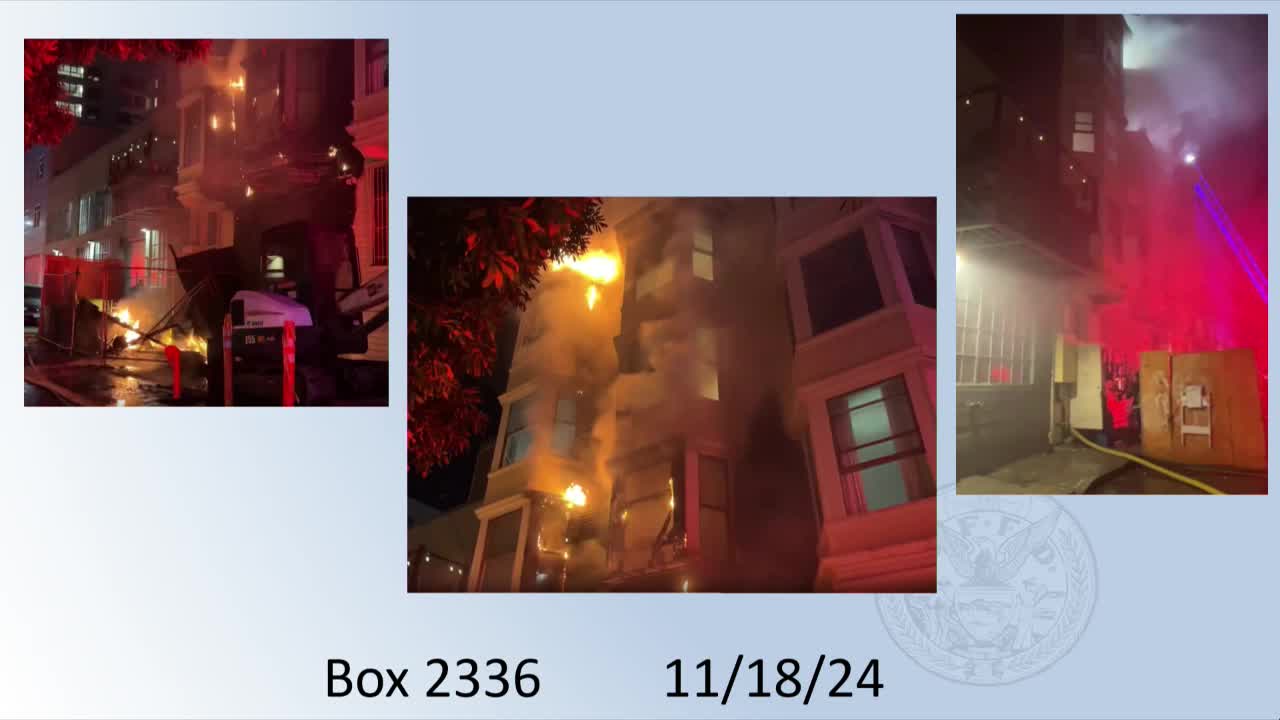SFFD reports two greater-alarm fires, highlights water-supply and access challenges
January 08, 2025 | San Francisco City, San Francisco County, California
This article was created by AI summarizing key points discussed. AI makes mistakes, so for full details and context, please refer to the video of the full meeting. Please report any errors so we can fix them. Report an error »

Deputy Chief of Operations Darius Letthrop told the Fire Commission on Jan. 8 that two greater-alarm fires during November and December underscored operational challenges for the San Francisco Fire Department.
Letthrop described a Nov. 18 fire (Box 2336) on Washburn Alley, behind 159 Ninth Street between Howard and Mission streets, that began as an outside fire and quickly extended into a four‑story residential building. He said the first engine found a significant body of fire that required immediate escalation, and responders encountered a separated high-voltage line that obstructed operations. Search-and-rescue and roof operations proceeded simultaneously, and a second alarm was struck as additional companies arrived.
The second incident, a Dec. 15 fire at the Hunters Point shipyard (near Crisp Avenue), was initially reported by a resident who observed heavy smoke. Letthrop said the fire involved a wood-constructed building attached to a large warehouse and that the shipyard's hydrant infrastructure proved unreliable; crews ran long hose lines and performed a relay/shuttle water operation until they located a reliable hydrant. No injuries or displacements were reported; the structure was abandoned.
Letthrop emphasized the operational lessons: anticipate atypical conditions, be prepared to establish a water-supply officer and relay operations, and plan for hydrant and access variability in locations such as shipyard properties. He identified equipment and tactics that helped — including longer hose capacity (from 1,000 to 1,400 feet on some rigs) and water-shuttling among engines — and commended field training for preparing crews to adapt on arrival.
Why it matters: both incidents required rapid escalation and nonstandard water-supply tactics. The Hunters Point response highlighted that hydrants on privately managed or legacy systems may be dry or unreliable, which can force reliance on engine tank water and relay operations until municipal supply is found.
Letthrop also highlighted recent training and staffing developments: the Division of Training graduated the 134th class, and NERT volunteer activity and specialized training continue to expand, including Spanish-language training and increased off-site classes.
The commission did not take action on operational matters at the meeting.
Letthrop described a Nov. 18 fire (Box 2336) on Washburn Alley, behind 159 Ninth Street between Howard and Mission streets, that began as an outside fire and quickly extended into a four‑story residential building. He said the first engine found a significant body of fire that required immediate escalation, and responders encountered a separated high-voltage line that obstructed operations. Search-and-rescue and roof operations proceeded simultaneously, and a second alarm was struck as additional companies arrived.
The second incident, a Dec. 15 fire at the Hunters Point shipyard (near Crisp Avenue), was initially reported by a resident who observed heavy smoke. Letthrop said the fire involved a wood-constructed building attached to a large warehouse and that the shipyard's hydrant infrastructure proved unreliable; crews ran long hose lines and performed a relay/shuttle water operation until they located a reliable hydrant. No injuries or displacements were reported; the structure was abandoned.
Letthrop emphasized the operational lessons: anticipate atypical conditions, be prepared to establish a water-supply officer and relay operations, and plan for hydrant and access variability in locations such as shipyard properties. He identified equipment and tactics that helped — including longer hose capacity (from 1,000 to 1,400 feet on some rigs) and water-shuttling among engines — and commended field training for preparing crews to adapt on arrival.
Why it matters: both incidents required rapid escalation and nonstandard water-supply tactics. The Hunters Point response highlighted that hydrants on privately managed or legacy systems may be dry or unreliable, which can force reliance on engine tank water and relay operations until municipal supply is found.
Letthrop also highlighted recent training and staffing developments: the Division of Training graduated the 134th class, and NERT volunteer activity and specialized training continue to expand, including Spanish-language training and increased off-site classes.
The commission did not take action on operational matters at the meeting.
View full meeting
This article is based on a recent meeting—watch the full video and explore the complete transcript for deeper insights into the discussion.
View full meeting
